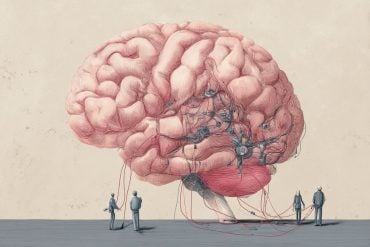Summary: New research shows that spontaneous eye blinks naturally sync to the beat of music, revealing a hidden form of auditory-motor synchronization that occurs even without conscious movement. In more than 100 participants listening to steady-tempo classical music, both blinks and brainwaves aligned with the rhythm, even when songs were played backward or replaced with tone-based beats.
This synchronization vanished when participants performed a task that diverted attention, indicating that rhythmic alignment depends on focused listening. The findings offer an effortless behavioral marker of rhythm processing and could support future clinical tools for neurological conditions involving timing and movement.
Key Facts:
- Beat-Locked Blinking: Spontaneous blinks aligned precisely with musical tempo across listeners, revealing an automatic, unconscious timing response.
- Brainwave Synchrony: Neural oscillations locked to the beat, showing tight coordination between auditory and motor systems.
- Attention-Dependent: Blink-to-beat synchronization disappeared under distraction, highlighting reliance on focused rhythm processing.
Source: PLOS
Yi Du and colleagues from the Chinese Academy of Sciences published an article in the open access journal PLOS Biology on November 18th detailing their findings about a new way our bodies naturally respond to music. Given a steady beat, our eyes blink in synchrony.
The neurological process that helps us move with the music is known as auditory-motor synchronization. This describes the way you tap your foot along with the radio or bob your head at a concert, or why some runners listen to songs with a specific number of beats per minute to keep pace.

However, this new study found that we don’t just respond to music with these gestures we can choose to start or stop. Some of our most involuntary movements are affected as well.
In over 100 participants, the researchers measured spontaneous blinks, the ones our eyes do without us usually even noticing. The researchers treated the participants to Western classical music, selecting songs that provided an even tempo. Not only did the participants’ blinks begin to sync up with the music, but their brainwaves also aligned.
The researchers played the tunes backwards to be sure the participants weren’t responding to other familiar musical queues, and the participants blinked in time regardless.
The researchers also played participants beats mimicking the pace of the music but at a single tone. Participants seemed to blink in rhythm slightly worse with real music, but the difference was not statistically significant.
The only factor that disrupted this synchronization was when the researchers gave the participants an unrelated task. While the music played, the participants had to wait for a red dot to appear on the screen in front of them.
Originally, the researchers had suspected that if the dot appeared in-beat with the music, the participants would notice it faster, but regardless of when the dot appeared in relation to the music, participants’ blinking was no longer matching up with the song. This finding surprised the researchers and demonstrated that even if we’re not aware of it, this response requires us to focus on the music.
The participants in the study were not musicians, meaning these synchronized blinks are not a product of musical training or ability. Studying phenomena like these can help us understand how pathways in the brain connect and how different senses and brain functions interact.
Some evidence also indicates that certain neurological conditions affecting body movement can be treated with music therapies that engage auditory-motor synchronization. The more uncovered about these neural pathways, the more useful these treatments can become.
Author Yi Du speaks to the study’s methodology:
“We found that people’s spontaneous eye blinks fall in step with the musical beat—even without being told to move—revealing a hidden link between hearing music and the oculomotor system.”
“Because blinks are effortless to measure, this behavior offers a simple, implicit window into how we process rhythm—and could one day support clinical screening for rhythm-related difficulties.”
“What surprised us most was how reliably a ‘small-movement’ like blinking locks to the beat—it’s a tiny action that reveals a deep coordination between hearing and action, which we did not expect at all”
“I loved that a simple, non-invasive signal—blinks—can act as a window into rhythm processing. It opens doors for studies outside the lab.”
“As someone who studies rhythm and prediction, I was struck that the eyes keep time with the ears—it’s an elegant, everyday signature of the brain’s timing mechanisms.”
“This project reminded us that small, overlooked behaviors can expose big principles of brain function.”
Funding: This work was supported by the Science and Technology Innovation 2030-Brain Science and Brain-inspired Artificial Intelligence Major Project (STI 2030—Major Project No. 2021ZD0201500) (https://www.most.gov.cn/index) to Y.D. and the Research Grants Council of the Hong Kong Special Administrative Region, China (Early Career Scheme; Project No. 24618124) (https://www.ugc.edu.hk/eng/rgc/) to X.T. The funders had no role in study design, data collection and analysis, decision to publish, or preparation of the manuscript.
Key Questions Answered:
A: The brain’s auditory-motor synchronization system links rhythmic sound to automatic oculomotor activity, causing spontaneous blinks to align with the beat.
A: Brainwave patterns lock to musical tempo, showing coordinated timing between auditory and motor systems.
A: Directing attention to a competing task breaks the blink-to-beat alignment, revealing that rhythm processing requires active listening focus.
About this music and neuroscience research news
Editorial Notes
- This article was edited by a Neuroscience News editor.
- Journal paper reviewed in full.
- Additional context added by our staff.
Author: Claire Turner
Source: PLOS
Contact: Claire Turner – PLOS
Image: The image is credited to Neuroscience News
Original Research: Open access.
“Eye blinks synchronize with musical beats during music listening” by Yi Du et al. PLOS Biology
Abstract
Eye blinks synchronize with musical beats during music listening
Auditory-motor synchronization, the alignment of body movements with rhythmic patterns in music, is a universal human behavior, yet its full scope remains incompletely understood.
Through four experiments with 123 young nonmusicians, integrating eye-tracking, neurophysiological recordings, white matter structural imaging, and behavioral analysis, we reveal a previously unrecognized form of synchronization: spontaneous eye blinks synchronize with musical beats.
Blinks robustly synchronized with beats across a range of tempi and independently of melodic cues.
Electroencephalogram recordings revealed a dynamic correspondence between blink timing and neural beat tracking.
Blink synchronization performance was linked to white matter microstructure variation in the left superior longitudinal fasciculus, a key sensorimotor pathway.
Additionally, the strength of blink synchronization reflected the modulation of dynamic auditory attention.
These findings establish blink synchronization as a novel behavioral paradigm, expanding the auditory-motor synchronization repertoire and highlighting the intricate interplay between music rhythms and oculomotor activity.
This discovery underscores a cross-modal active sensing mechanism, offering new insights into embodied music perception, rhythm processing, and their potential clinical applications.






